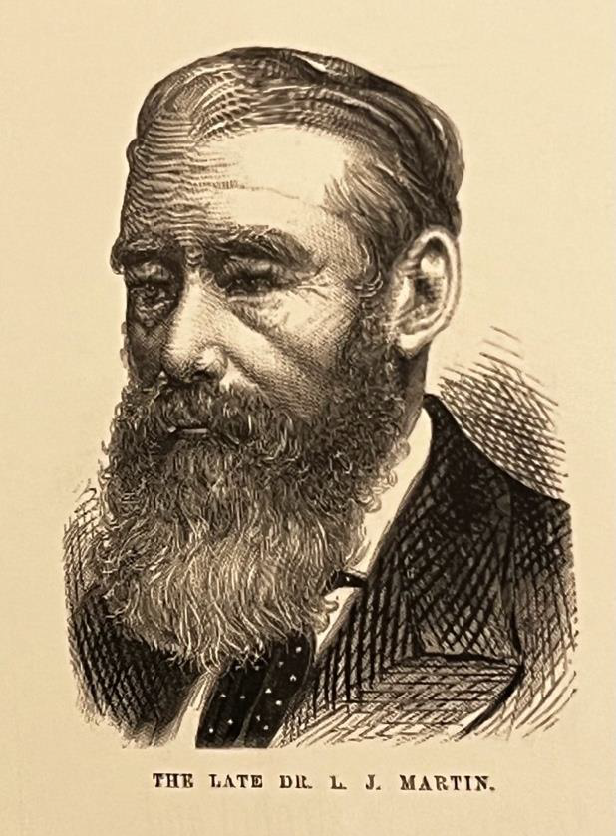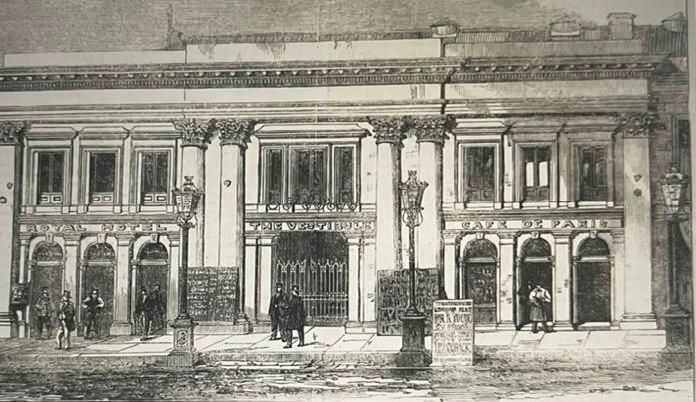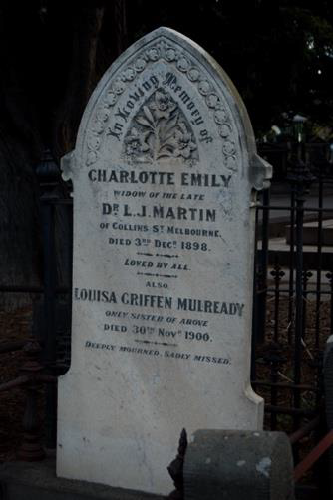 M.D.(Melb) 1862, Lic.Apoth. Dublin 1851 L.R.C.S. (Edin.),1853
M.D.(Melb) 1862, Lic.Apoth. Dublin 1851 L.R.C.S. (Edin.),1853
Born: Dundalk, Ireland 1826
Died: 19 January 1879 Cannes, France.
Gynaecologist and Obstetrician.
President of the Medical Society of Victoria in 1865.
Melbourne had seen a dramatic surge in population following the Goldrush of the 1850’s. A Medical School at the University of Melbourne was opened in 1862 when medical men together with the University Council saw the need to create a tertiary medical learning environment in this new developing community. The University had the power to confer degrees in medicine, and had been doing so previously for medical graduates of approved overseas courses, but did not have the resources to teach courses itself. It began by establishing a pathology museum and by teaching courses in anatomy, pathology, materia medica and theory of medicine but without clinical teaching.
The University tardiness was not appreciated by the Medical Society of Victoria, and they spoke fervently to start the process despite the Government declaring “no money.” A garden shed in Dr Halford’s backyard as the dissecting room was the beginning and the rest followed.
Martin was one of the overseas graduates whose qualifications were recognised by Melbourne University. In 1867 he was appointed physician to the Lying-in Hospital.
Names such as Halford, Robertson and Neild were Foundation lecturers at this new Medical School Another doctor named as the Foundation Lecturer was Robert Thomas Tracy.
Dr Lawrence Joseph Martin was a close colleague of Robert Tracy. These two men were both Presidents of Medical Society of Victoria, Robert Tracy in 1860 and Lawrence Martin five years later. Both men were specialists in Obstetrics and Diseases of Women and Children. Lawrence Martin did contribute significantly to the formation of the Medical School but is not mentioned often in present histories.
In 1870 Martin visited Europe and on a twelve months’ tour inspected every institution that could widen his specialist knowledge. In England he read a paper on behalf of Dr. Richard Tracy to the Obstetrical Society in London. It is assumed that Richard Tracy and Lawrence Martin were not only professional colleagues but friends. He is named in Richard Tracy’s will with respect to his property in 190 Collins Street. When Tracy died in 1874, Martin bought his Collins Street house and practice. Thereafter, Dr Lawrence Joseph Martin replaced his colleague as Melbourne’s leading obstetrician.
Dr Lawrence Martin did have a specific cohort of admirers as we see in the newspaper of 1878 when he took a leave of absence to go overseas mainly due to deteriorating health.
The Argus Sat 15 Jun 1878
Presentation to Dr L J Martin
The subjoined address, very beautifully illuminated by Mr C Turner, accompanied by a purse of 230 sovereigns, was presented to Dr Martin on Thursday by a number of ladies, chiefly patients of his. Dr Martin leaves for England by the Northumberland on Wednesday next:
To Lawrence Joseph Martin, Esq., M.D., from his Melbourne lady friends Melbourne, June 13,1878
"Dear Dr Martin - We whose names are here set down desire to tell you how much we regret the necessity which has obliged you to relinquish your professional duties in order again to visit the old country. That you may speedily return to your adopted land, with the perfectly renewed health you are going to seek is our earnest prayer
We hope to see you again in the active exercise of those powers you have, for so many years used with credit to your noble calling and continual benefit to your fellow creatures. We can each of us bear personal testimony to the success with which you have practised your art in this colony, and to the kindness, tenderness, and considerate gentleness with which, often under circumstances of great anxiety, you have borne yourself "
Be sure that you will bear with you our most affectionate regard, and that whenever you return, you will be welcomed back to home and to your many warm friends
This was signed by a committee of ladies, and the names of the contributors, 96 in number, were attached.”
Such a letter reported in the newspaper showed the female community’s respect for Dr Lawrence Joseph Martin.
Lawrence Martin was an Irishman, born in Dundalk County Louth: his life as a young man was not easy. In 1826, he began the study of medicine by being apprenticed to an apothecary in Drogheda. From 1848 he attended lectures and gained hospital experience in Dublin. This qualified him for examination at the Dublin Apothecaries’ Hall, whose licence he obtained in 1851 and two years later that of the Edinburgh College of Surgeons. He attended the lectures and completed the hospital practice in what spare time he could find while earning his living. This young man, like many of his colleagues at the time, found little chance of practising his profession in the British Isles, so he became a ship’s doctor on an immigration ship to the colony of New South Wales. He must have liked what he saw!
He served on a return journey of an immigrant ship in the 1850s. He returned to Ireland, married and travelled back to Melbourne and settled with his wife Charlotte Emily (Benson) in 1854 in the colony of Melbourne establishing his home in a small cottage at 89 Russell Street.
He struggled for some years but is eventually he succeeded in establishing his practice. His life was somewhat complicated by personal jealousies and petty disagreements with the medical profession. He persevered.
Martin obtained further qualifications a M.D. degree from the University of Melbourne in 1862 and three years later he became one of the Honorary Physicians to the Melbourne Hospital. Election as one of the Honorary Physicians to the Lying-In Hospital in 1867 gave Dr. Martin valuable experience in obstetrics for which he had discovered a particular aptitude and interest. In the years that followed both at the hospital and in private practice, his skill in this field brought him reputation and success, hence the letter in The Argus in 1878.
At this time in the colony’s medical history a controversy occurred which involved many committee members and presidents of the Medical Society of Victoria. Obviously, there was significant disharmony, and it is worth alluding to one of these issues.
The Newspaper Truth in 1916 reflected on the sensational court case of 1866 of “obstetrical care” involving Dr James Beaney being charged with the murder of Mary Lewis. Notable Melbourne medical men were involved in giving evidence, Dr Richard Tracy and Dr Lawrence Martin and Dr George Britton Halford. There was significant amount of reporting in newspapers giving us more personal images of all these men, including the accused, James Beaney.
The proceedings stated Halford was a “University professor and had a limited practice”.
Of Dr Martin, the review of the court case said “Dr. Martin shared with Dr. Tracy a leading obstetric practice in Melbourne. He was held in the highest respect by all classes; an unassuming, well-living, charitable, and practical man. He was such a man as young men in Melbourne looked up to, socially and morally. Unfortunately, he was not a robust man……. He worked as long as he was able; but gave up in the late sixties, and retired to Cannes, in France, where he died.” “His evidence was very short, to the point, and without any tinge of animus such as had been displayed by other medical witnesses.”
There are many references to the court case about the eccentric, flamboyant and very rich James Beaney. The charge of murder of Mary Lewis alluded to “abortion” but he was exonerated due to his lawyer’s adeptness of examination of the expert medical witnesses.
Beaney did belong to the Medical Society of Victoria but resigned in 1870 after they declared he was a “bogus practitioner” despite his extensive qualifications.
In his will he left a considerable amount of money to various institutions in Victoria, England and Scotland including the University of Melbourne and Canterbury Institute in England. His University of Melbourne scholarships continue today. Unfortunately, his gifting was so great that he did not provide sufficiently for his surviving relatives! Obviously, his giving was somewhat related to his egomania.
Dr Martin was an inaugural committee member of the Victorian Medical Benevolent Society, a group of doctors who in 1865 formed an association to assist the welfare of doctors and their families in times of need. Dr Lawrence Martin continued as a member for the rest of his life suggesting he was a sympathetic caring person.
The Medical Society of Victoria meetings at the time of Dr Lawrence Martin’s Presidency were related to issues of appointments to respected medical positions in government and institutions, competency of all medical personnel, fees, and acknowledgment of recent textbooks, academic papers, research and notable scientific achievements. There was always awareness of the infectious diseases around the world and the risk of these infections coming to Australian shores.
A hint of their forward thinking was a question of having a specific building built for the Society to use as their headquarters, hence a Building Fund was commenced.

The Restaurant Café de Paris Bourke Street Melbourne
The Annual Meeting of the Society on October 27, 1865, took place at Café de Paris (in the area of Florentino’s today) with President Dr Martin giving the loyal and national toasts. He then proceeded to announce with much formality, “the high prosperity of the society in the financial, social and scientific aspects.” He continued to say, “it bore testimony of its usefulness to prevent interference to prevent obnoxious legislation and the value of its ordinary meeting at which excellent scientific papers had been read….” “His speech was received with cheers” Dr Tracy in an elaborate speech proposed a toast to the of the “Medical Journal” to which its editor for many years Dr Neild responded……”
Similarly, there is a record of a meeting of the Medical Society of Victoria in June 1878 which is recorded as a formal farewell to Dr Martin. Acknowledgement was made of his commitment to the Medical Society of Victoria over the 23 years he had been a member. The Hon Secretary Dr Nield presented him with a very handsome silver tankard and salver with the inscription
"To Dr L J Martin, from the Medical Society of Victoria, 17th June 1878
Dr Martin spoke of the great pleasure it afforded him to receive this token of the kindly feeling of his professional brethren towards him. During his long residence in Victoria he had received nothing but kindness from the members of the medical profession. He was happy to say that the troubles that had so long afflicted the society had disappeared, and now the members worked harmoniously together for their mutual instruction and advancement in the noble profession they had chosen. Dr Martin’s health was then drunk, with hearty wishes for his speedy return, and soon after the company separated.”

Despite much controversy noted in his career and the acknowledgement of this with forgiveness, there were many statements of his considerable contribution to Obstetrics and Gynaecology in the early days of Melbourne before Federation.
“Brain disease clouded his last years”. Hoping to find a cure, he left Melbourne for England in 1878. After arriving in London, he was seen by Dr Hughlings Jackson a notable neurologist. His family decided to travel to the French Rivera for a “better climate”. He died at Cannes on 19th January 1879, at the age of fifty-three. There is no definitive record of his final burial place, but probably in Ireland.
It was said of him by his colleagues: He had a pleasant manner with his patients; was always cheerful, loved the social life, and was a popular figure in the life of the town. He was a fluent speaker at medical gatherings and a competent contributor to medical journals.
Any doctor today would appreciate this description. What more could be said about Dr Lawrence Joseph Martin.
His wife Charlotte is buried in the Melbourne General Cemetery dying in 1898, her headstone bears his name.
Last updated 12 March 2025
Sources: The Royal Women’ Hospital Biographical Compendium; K F Russell The Melbourne Medical School 1862-1926; Victorian Medical Benevolent Society 1865-2012; Trove ; Find a Grave.
Article by Dr Jean Douglas and Dr Allan Mawdsley OAM
